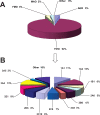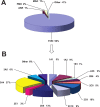Survey of Human Oxidoreductases and Cytochrome P450 Enzymes Involved in the Metabolism of Xenobiotic and Natural Chemicals
- PMID: 25485457
- PMCID: PMC4303333
- DOI: 10.1021/tx500444e
Survey of Human Oxidoreductases and Cytochrome P450 Enzymes Involved in the Metabolism of Xenobiotic and Natural Chemicals
Abstract
Analyzing the literature resources used in our previous reports, we calculated the fractions of the oxidoreductase enzymes FMO (microsomal flavin-containing monooxygenase), AKR (aldo-keto reductase), MAO (monoamine oxidase), and cytochrome P450 participating in metabolic reactions. The calculations show that the fractions of P450s involved in the metabolism of all chemicals (general chemicals, natural, and physiological compounds, and drugs) are rather consistent in the findings that >90% of enzymatic reactions are catalyzed by P450s. Regarding drug metabolism, three-fourths of the human P450 reactions can be accounted for by a set of five P450s: 1A2, 2C9, 2C19, 2D6, and 3A4, and the largest fraction of the P450 reactions is catalyzed by P450 3A enzymes. P450 3A4 participation in metabolic reactions of drugs varied from 13% for general chemicals to 27% for drugs.
Figures




References
-
- Rendic S. (2002) Summary of information on human CYP enzymes: Human P450 metabolism data. Drug Metab. Rev. 34, 83–448. - PubMed
-
- Rendic S.; Di Carlo F. J. (1997) Human cytochrome P450 enzymes: a status report summarizing their reactions, substrates, inducers, and inhibitors. Drug Metab. Rev. 29, 413–580. - PubMed
-
- ADME Database: WEB Searchable ADME Database of Substrates, Inhibitors, Inducers and Activators of Cytochrome P450, Other Enzymes and Drug Transporters, Fujitsu Kyushu System Ltd., Fukuoka, Japan, http://jp.fujitsu.com/group/kyushu/en/services/admedatabase/.
-
- Williams J. A.; Hyland R.; Jones B. C.; Smith D. A.; Hurst S.; Goosen T. C.; Peterkin V.; Koup J. R.; Ball S. E. (2004) Drug-drug interactions for UDP-glucuronosyltransferase substrates: a pharmacokinetic explanation for typically observed low exposure (AUCi/AUC) ratios. Drug Metab. Dispos. 32, 1201–1208. - PubMed
Publication types
MeSH terms
Substances
Grants and funding
LinkOut - more resources
Full Text Sources
Other Literature Sources
Molecular Biology Databases

